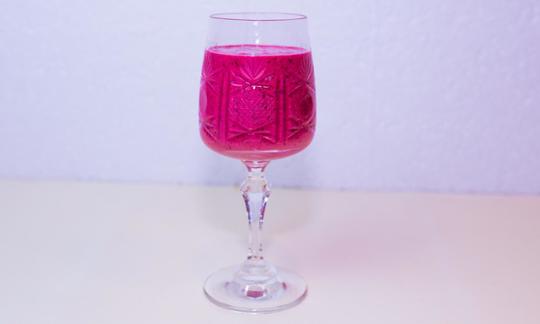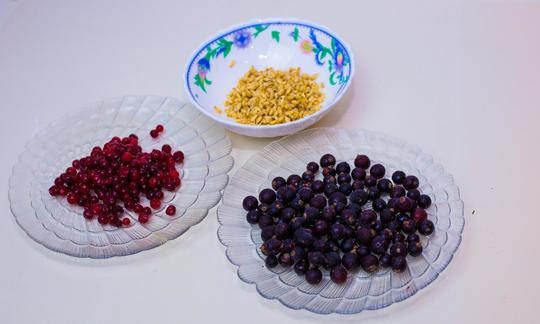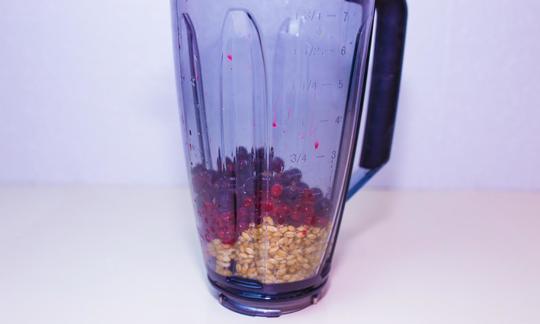Refreshing Berry Smoothie with Sprouted Wheat
raw-vegan
Ingredients (for servings, )
| For the berry smoothie | |
|---|---|
| 2 ⅛ oz | Wheat, germinated (wheat sprouts, raw, organic?) |
| 2 ⅛ oz | Cranberries (lingonberries), raw (organic?) |
| 2 ⅛ oz | Blackcurrants, raw (cassis, currants, organic?) |
| 1 tbsp | Honey (bee honey, raw?, organic?) (0.74 oz) |
| 200 ml | Drinking water, raw (organic?) (7.0 oz) |
Equipment
- blender or hand-held blender / immersion blender
- refrigerator
Type of preparation
- chop or grind
- food preparation without heating
- blend
- cool
Preparation
For the berry smoothie
Rinse the sprouted wheat and the berries.Add the sprouted wheat, lingonberries, black currants, honey, and water to the blender. Blend until smooth.
You can adjust the amount of water depending on the consistency you prefer. You may want to begin with a little less water and increase the amount as necessary.
Garnish and serve
Garnish the smoothie with a lemon or orange wedge. Chill before serving.
|
Nutritional Information per person
Convert per 100g
|
2000 kcal | |
|---|---|---|
| Energy | 123 kcal | 6.1% |
| Fat/Lipids | 0.66 g | 0.9% |
| Saturated Fats | 0.08 g | 0.4% |
| Carbohydrates (inc.dietary fiber) | 29 g | 10.7% |
| Sugars | 10 g | 11.6% |
| Fiber | 1.2 g | 4.9% |
| Protein/Albumin | 2.8 g | 5.6% |
| Cooking Salt (Na:10.4 mg) | 26 mg | 1.1% |
| Essential micronutrients with the highest proportions | per person | 2000 kcal | |
|---|---|---|---|
| Vit | Vitamin C (ascorbic acid) | 59 mg | 73.0% |
| Min | Manganese, Mn | 0.72 mg | 36.0% |
| Min | Selenium, Se | 13 µg | 23.0% |
| Min | Copper, Cu | 0.17 mg | 17.0% |
| Prot | Tryptophan (Trp, W) | 0.04 g | 15.0% |
| Elem | Phosphorus, P | 81 mg | 12.0% |
| Min | Iron, Fe | 1.3 mg | 9.0% |
| Elem | Magnesium, Mg | 35 mg | 9.0% |
| Elem | Potassium, K | 177 mg | 9.0% |
| Prot | Threonine (Thr, T, irreversibly transaminated) | 0.08 g | 9.0% |
Detailed Nutritional Information per Person for this Recipe
The majority of the nutritional information comes from the USDA (US Department of Agriculture). This means that the information for natural products is often incomplete or only given within broader categories, whereas in most cases products made from these have more complete information displayed.
If we take flaxseed, for example, the important essential amino acid ALA (omega-3) is only included in an overarching category whereas for flaxseed oil ALA is listed specifically. In time, we will be able to change this, but it will require a lot of work. An “i” appears behind ingredients that have been adjusted and an explanation appears when you hover over this symbol.
For Erb Muesli, the original calculations resulted in 48 % of the daily requirement of ALA — but with the correction, we see that the muesli actually covers >100 % of the necessary recommendation for the omega-3 fatty acid ALA. Our goal is to eventually be able to compare the nutritional value of our recipes with those that are used in conventional western lifestyles.
| Essential fatty acids | per person | 2000 kcal |
|---|---|---|
| Alpha-Linolenic acid; ALA; 18:3 omega-3 | 0.09 g | 4.0% |
| Linoleic acid; LA; 18:2 omega-6 | 0.24 g | 2.0% |
| Essential amino acids | per person | 2000 kcal |
|---|---|---|
| Tryptophan (Trp, W) | 0.04 g | 15.0% |
| Threonine (Thr, T, irreversibly transaminated) | 0.08 g | 9.0% |
| Isoleucine (Ile, I) | 0.09 g | 7.0% |
| Leucine (Leu, L) | 0.16 g | 7.0% |
| Phenylalanine (Phe, F) | 0.11 g | 7.0% |
| Valin (Val, V) | 0.11 g | 7.0% |
| Lysine (Lys, K, irreversibly transaminated) | 0.08 g | 4.0% |
| Methionine (Met, M) | 0.04 g | 4.0% |
| Vitamins | per person | 2000 kcal |
|---|---|---|
| Vitamin C (ascorbic acid) | 59 mg | 73.0% |
| Vitamin B6 (pyridoxine) | 0.10 mg | 8.0% |
| Vitamin B1 (Thiamine) | 0.09 mg | 8.0% |
| Vitamin B3 (Niacin) | 1.1 mg | 7.0% |
| Vitamin B5 (Pantothenic acid) | 0.41 mg | 7.0% |
| Vitamin B9, B11 (Folate, as the active form of folic acid) | 13 µg | 6.0% |
| Vitamin B2 (Riboflavin) | 0.07 mg | 5.0% |
| Vitamin E, as a-TEs | 0.58 mg | 5.0% |
| Vitamin A, as RAE | 5.4 µg | 1.0% |
| Vitamin B7 (Biotin, ex vitamin H) | 0.72 µg | 1.0% |
| Essential macroelements (macronutrients) | per person | 2000 kcal |
|---|---|---|
| Phosphorus, P | 81 mg | 12.0% |
| Magnesium, Mg | 35 mg | 9.0% |
| Potassium, K | 177 mg | 9.0% |
| Calcium, Ca | 33 mg | 4.0% |
| Sodium, Na | 10 mg | 1.0% |
| Essential trace elements (micronutrients) | per person | 2000 kcal |
|---|---|---|
| Manganese, Mn | 0.72 mg | 36.0% |
| Selenium, Se | 13 µg | 23.0% |
| Copper, Cu | 0.17 mg | 17.0% |
| Iron, Fe | 1.3 mg | 9.0% |
| Zinc, Zn | 0.67 mg | 7.0% |
| Fluorine, F | 84 µg | 2.0% |
| Iod, I (Jod, J) | 1.5 µg | 1.0% |
The lingonberries and black currants give this refreshing berry smoothie its pink color and make it a good source of antioxidants.
Lingonberries: Lingonberries have a tart flavor and are rich in vitamins and minerals. The best time to pick lingonberries is around the end of August to the beginning of September. Some varieties have a second crop that is ready to be picked later in September or in October. The presence of anthocyanins in lingonberries is one possible reason why the fruit helps protect against urinary tract and biliary duct infections, rheumatic diseases, and gout.
Sprouting wheat: You can purchase wheat berries for sprouting in some grocery stores, health food stores, and online. It’s not at all hard to sprout wheat yourself. Soak the wheat berries in cold water for 8 to 12 hours. Drain, rinse with water, and drain again. Repeat rinsing and draining at least twice a day. The wheat berries will begin to sprout within one to three days after they are soaked. During the sprouting process, the enzymes multiply and the starch converts to sugar. Proteins convert back to their amino acid building blocks, while at the same time the vitamin and mineral content increases. Since the water content of the wheat berries increases, sprouted wheat contains a lower percentage of calories and fat. Sprouted wheat is rich in fiber and is easily digested. It has a slightly sweet flavor that can turn bitter if the sprouts grow larger than the length of the wheat kernel. You can store sprouted wheat up to four days in the crisper of your refrigerator.
Lingonberry alternative: In place of lingonberries, you can use cranberries. Both lingonberries and cranberries are in the heath or heather family. And since they have such a similar flavor, they are often thought to be the same berry. However, lingonberries originated in Europe and Asia and are much smaller (size of a pea) than cranberries (size of a small olive), which are native to North America. Lingonberries grow on short, dense bushes and spread by underground stems whereas cranberries grow on low, creeping vines and are propagated by cuttings.
Honey alternative: You can make a vegan smoothie by replacing the honey with agave nectar, maple syrup, or dandelion honey.
Variations: You can vary the flavor by using other favorite berries and fruits. Add more water or orange juice to the smoothie if it is too thick. Add a few drops of lemon juice to give your smoothie a bright citrusy note.








